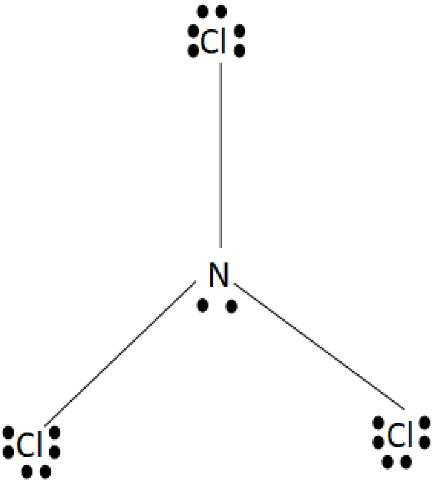
The correct dot formulation for nitrogen trichloride has:
A. \[2N - Cl\] bonds, \[1N = Cl\]bond, and 8 lone pairs of electrons.
B. \[3N - Cl\] bonds and 10 lone pairs of electrons.
C. \[1N - Cl\] bond, \[2N = Cl\]bonds, and 7 lone pairs of electrons.
D. \[3N = Cl\] bonds and 6 lone pairs of electrons.
Answer
220.5k+ views
Hint: The geometry structure of the nitrogen trichloride is tetrahedral. The shape of this compound is pyramidal.
Complete Step by Step Solution:
1. The electronic configuration of the nitrogen atom \[[He]2{s^2}2{p^3}\]and the chlorine atom is \[[Ne]3{s^2}3{p^5}\].
2. The valence electrons of the nitrogen atom and chlorine atom are five and seven.
3. The total number of valence electrons of the nitrogen trichloride is twenty-six including the three chlorine atoms.
4. The nitrogen forms three bonds with the three chlorine atoms in which three electrons of nitrogen and three electrons of each chlorine are used to form a structure.
5. A total of six electrons are used to form this compound and a total of twenty electrons are remaining as lone pairs on the nitrogen and chlorine atoms.
6. There is one lone pair on the nitrogen and three lone pairs on each chlorine atom.
7. The dot structure of nitrogen trichloride is presented below:

Image: nitrogen trichloride
Thus, the option (B) is correct.
Additional information:
1. The structure of nitrogen trichloride is tetrahedral that includes both lone pairs and bond pairs since the lone pair is considered to be the bond pair.
2. The structure of nitrogen trichloride is trigonal pyramidal when considering only the bond pairs but not the lone pair.
Note: The Hybridization of the nitrogen trichloride \[s{p^3}\]that involves one 2s and three 2p orbitals that mix to form a new orbital with the same energy.
Complete Step by Step Solution:
1. The electronic configuration of the nitrogen atom \[[He]2{s^2}2{p^3}\]and the chlorine atom is \[[Ne]3{s^2}3{p^5}\].
2. The valence electrons of the nitrogen atom and chlorine atom are five and seven.
3. The total number of valence electrons of the nitrogen trichloride is twenty-six including the three chlorine atoms.
4. The nitrogen forms three bonds with the three chlorine atoms in which three electrons of nitrogen and three electrons of each chlorine are used to form a structure.
5. A total of six electrons are used to form this compound and a total of twenty electrons are remaining as lone pairs on the nitrogen and chlorine atoms.
6. There is one lone pair on the nitrogen and three lone pairs on each chlorine atom.
7. The dot structure of nitrogen trichloride is presented below:

Image: nitrogen trichloride
Thus, the option (B) is correct.
Additional information:
1. The structure of nitrogen trichloride is tetrahedral that includes both lone pairs and bond pairs since the lone pair is considered to be the bond pair.
2. The structure of nitrogen trichloride is trigonal pyramidal when considering only the bond pairs but not the lone pair.
Note: The Hybridization of the nitrogen trichloride \[s{p^3}\]that involves one 2s and three 2p orbitals that mix to form a new orbital with the same energy.
Recently Updated Pages
Electricity and Magnetism Explained: Key Concepts & Applications

JEE Energetics Important Concepts and Tips for Exam Preparation

JEE Isolation, Preparation and Properties of Non-metals Important Concepts and Tips for Exam Preparation

JEE Main 2021 July 25 Shift 1 Question Paper with Answer Key

JEE Main 2021 July 22 Shift 2 Question Paper with Answer Key

States of Matter Chapter For JEE Main Chemistry

Trending doubts
JEE Main 2026: Application Form Open, Exam Dates, Syllabus, Eligibility & Question Papers

Derivation of Equation of Trajectory Explained for Students

Hybridisation in Chemistry – Concept, Types & Applications

Understanding the Angle of Deviation in a Prism

How to Convert a Galvanometer into an Ammeter or Voltmeter

JEE Main Marking Scheme 2026- Paper-Wise Marks Distribution and Negative Marking Details

Other Pages
NCERT Solutions For Class 11 Chemistry Chapter 7 Redox Reaction

JEE Advanced Marks vs Ranks 2025: Understanding Category-wise Qualifying Marks and Previous Year Cut-offs

Hydrocarbons Class 11 Chemistry Chapter 9 CBSE Notes - 2025-26

Thermodynamics Class 11 Chemistry Chapter 5 CBSE Notes - 2025-26

NCERT Solutions ForClass 11 Chemistry Chapter Chapter 5 Thermodynamics

Equilibrium Class 11 Chemistry Chapter 6 CBSE Notes - 2025-26




